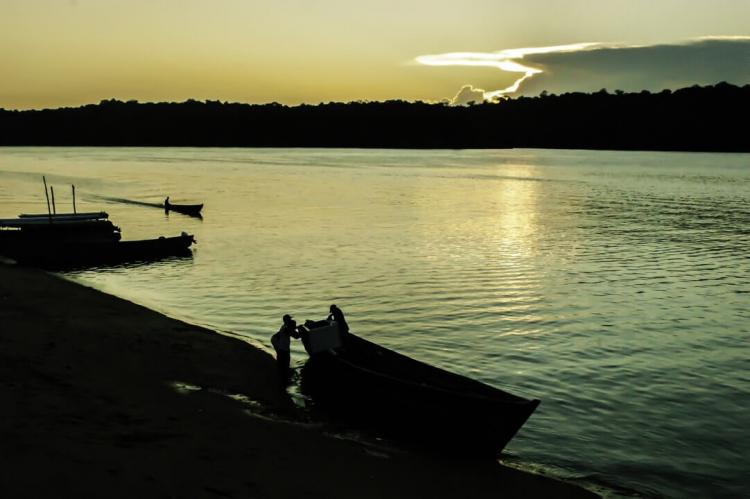Cabo Orange National Park: A Sanctuary of Biodiversity and Natural Beauty
Cabo Orange National Park, located in the northern Brazilian state of Amapá, is a remarkable expanse of natural beauty and ecological significance. Nestled along the coastline, it includes continental and marine environments and is crucial to Brazil's efforts to preserve its biodiversity and ecosystems.
Preserving Paradise: The Natural Wonders of Cabo Orange National Park
Cabo Orange National Park, located in the northern Brazilian state of Amapá, is a remarkable expanse of natural beauty and ecological significance. The park, established in 1980, spans 657,318 hectares (1,624,270 acres) and includes continental and marine environments. Nestled along the coastline and bordering French Guiana to the north, Cabo Orange is crucial to Brazil's efforts to preserve its rich biodiversity and unique ecosystems. Managed by the Chico Mendes Institute for Biodiversity Conservation (ICMBio), the park is a testament to the importance of conservation and sustainable use of natural resources.
Geographic and Ecological Significance
Location and Boundaries
Cabo Orange National Park is situated within Calçoene and Oiapoquein municipalities, near the French Guiana border. The Atlantic Ocean bounds it to the east, the Uaçá and Juminã Indigenous lands to the west, and the Vila Velha Settlement Project in a small stretch to the west. The park's strategic location along the coastline and proximity to various Indigenous lands underscore its ecological and cultural importance.
Diverse Ecosystems
The park encompasses a variety of ecosystems, including mangroves, flooded fields, clean fields interspersed with savannahs, upland forests, and marine environments. Approximately 200,000 hectares (494,000 acres) of the park's area lie within ocean waters, making it a significant marine park. These diverse habitats are home to a wide range of flora and fauna, contributing to the park's rich biodiversity.
Unique Features
Cabo Orange National Park is distinguished by its periodically and permanently flooded grasslands, unique to the Amazon region. These grasslands, along with the extensive mangrove forests, play a crucial role in the local ecosystem. The mangroves, often called "fish nurseries," are vital for maintaining some of Brazil's most important fisheries. They provide a haven for juvenile fish and other marine species, ensuring the sustainability of the region's fisheries.
Conservation and Management
Objectives and Management
Cabo Orange National Park's primary objective is to preserve its natural ecosystems, which are of great ecological relevance and scenic beauty. The park's designation allows for scientific research, environmental education, and eco-tourism, promoting both conservation and sustainable development. Managed by ICMBio, the park is also supported by the Amazon Region Protected Areas Program, reflecting its significance within broader conservation efforts.
Adjoining Conservation Areas
Cabo Orange National Park adjoins the Amapá State Forest, a sustainable use conservation unit established in 2006 that covers 2,369,400 hectares (5,855,000 acres). This proximity enhances the park's ecological connectivity, forming part of the Amapá Biodiversity Corridor created in 2003. This corridor aims to ensure the continuity and integrity of ecosystems across a vast area, facilitating the movement and survival of various species.
Rich Biodiversity
Flora and Fauna
Cabo Orange National Park is a biodiversity hotspot, home to numerous globally threatened species. To date, 358 species of birds, 19 species of plants, and 54 species of mammals have been identified within the park. This rich biodiversity highlights the park's critical role in conserving endangered or vulnerable species.
Protected Species
Several iconic and endangered species are protected within the park, including:
- Giant Armadillo (Priodontes maximus)
- Giant Anteater (Myrmecophaga tridactyla)
- Jaguar (Panthera onca)
- Oncilla (Leopardus tigrinus)
- Black-bearded Saki (Chiropotes satanas)
- Green Sea Turtle (Chelonia mydas)
- Smalltooth Sawfish (Pristis pectinata)
- West Indian Manatee (Trichechus manatus)
- Amazonian Manatee (Trichechus inunguis)
These species contribute to the park's ecological richness and underline the importance of ongoing conservation efforts.
Socio-Economic Aspects
Local Communities and Activities
The park is a haven for wildlife and an important area for local communities. The Indigenous lands and the Vila Velha Settlement Project near the park reflect the human dimension of the landscape. Local communities engage in various sustainable activities, including eco-tourism, which provides economic benefits while promoting conservation awareness.
Eco-Tourism and Education
Cabo Orange National Park's stunning landscapes and diverse ecosystems make it an ideal destination for eco-tourism. Visitors can explore mangrove forests, observe a wide range of bird species, and experience the unique flooded grasslands. Educational programs and guided tours help raise awareness about the importance of conservation and the role of protected areas in preserving biodiversity.
Conclusion
Cabo Orange National Park is a vital sanctuary for biodiversity and natural beauty in northern Brazil. Its diverse ecosystems, rich flora and fauna, and commitment to conservation make it a critical component of Brazil's natural heritage. As efforts continue to preserve and protect this unique landscape, Cabo Orange National Park will remain a beacon of ecological and cultural significance, inviting all to appreciate and safeguard its treasures.
